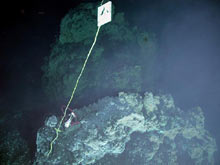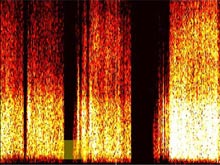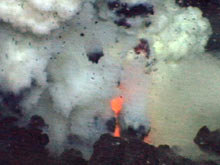Every visit to Brimstone Pit with the remotely operated vehicle (ROV) Jason was more incredible than the last, until finally we saw glowing red lava jetting out of the vent on our last dive! That sight was simply beyond belief! Click image for larger view and image credit.
If we were observing this type of eruptive activity on land we would have to run for our lives! At Brimstone Pit the pressure of 560 m (1,837 ft) of water over the site reduces the power of the explosive bursts. Also, the water quickly slows down the rocks and ash that are violently thrown out of the vent. Click image for larger view and image credit.
Close to the Fire
April 29, 2006
Bill Chadwick
Geologist
Cooperative Institute for Marine Resources Studies Program, Oregon State University
NOAA Vents Program, Pacific Marine Environmental Laboratory — Newport, Oregon
![]() The
extremely dynamic Brimstone Pit. (Quicktime, 2 Mb.)
The
extremely dynamic Brimstone Pit. (Quicktime, 2 Mb.)
![]()
![]() Brimstone
Pit erupts with glowing red lava jetting out of the vent. (Quicktime, 2.5 Mb.)
Brimstone
Pit erupts with glowing red lava jetting out of the vent. (Quicktime, 2.5 Mb.)
![]() Brimstone
Pit erupting with glowing red lava and gas bubbles. (Quicktime,
2.1 Mb.)
Brimstone
Pit erupting with glowing red lava and gas bubbles. (Quicktime,
2.1 Mb.)
![]() A Brimstone
Pit sulfur plume envelopes the Jason remotely operated vehicle. (Quicktime, 3.3 Mb.)
A Brimstone
Pit sulfur plume envelopes the Jason remotely operated vehicle. (Quicktime, 3.3 Mb.)
![]() The
pulse and shake of the Brimstone Pit during another eruption. (Quicktime, 1.9 Mb.)
The
pulse and shake of the Brimstone Pit during another eruption. (Quicktime, 1.9 Mb.)
We have just finished our last of six dives at NW Rota-1. Even though we briefly visited here on two previous expeditions, we felt this site still had great potential for further discovery. How true this turned out to be!
So what have we learned from our observations at this erupting submarine volcano? First, the activity at this site is extremely dynamic. During every dive we saw something new and different. The style of eruption at the vent changed minute by minute. And there was a distinct progression over the week we were here. Right before we arrived, a major landslide must have occurred that originated near Brimstone Pit (the eruptive vent). A turbid (cloudy) layer from the slide surrounded the volcano's lower flanks, and during our first dive we could barely see anything because the entire summit was enveloped in a huge eruption cloud. The very next day the water had miraculously cleared, and we found that half of Brimstone Pit had fallen away and the sea floor around the vent was swept clean of recent lava. Over the next week, we observed eruptive activity that gradually increased in intensity and vigor. By the end of the week, a 5-m-high (16-plus-ft) cone made of ash and lava blocks had built up over the vent, and the turbid layer on the flanks was almost gone. Every visit to Brimstone Pit with the remotely operated vehicle (ROV) Jason was more incredible than the last, until finally we saw glowing red lava jetting out of the vent on our last dive! That sight was simply beyond belief!
We have also learned something rather counterintuitive: that observing explosive volcanic activity at a submarine volcano is easier and more revealing in many ways than on land! This is because the eruptive activity, although violent at times, is usually limited to a small area due to the dampening effect of the surrounding water. For example, at Brimstone Pit the pressure of 560 m (1,837 ft) of water over the site reduces the power of the explosive bursts. Also, the water quickly slows down the rocks and ash that are violently thrown out of the vent. Most of the time, Jason could hover just a few meters away and watch for hours. You could never do that on land! In addition, we were able to visualize the release of volcanic gases from the erupting lava with new clarity, with the help of the streams of bubbles and multicolored plumes as they were emitted. It is surprising that the ocean makes some processes more observable than on land!

In addition to seeing new wonders, we were able to listen to the volcanic activity using a hydrophone (a portable underwater microphone), with the help of our NOAA Vents /Oregon State University colleagues on shore. It is the small white cylinder at the base of the marker. Click image for larger view and image credit.

Scientist recorded hydrophone sound data from NW Rota-1 during an eruption. The hydrophone was placed on the summit of the volcano a safe distance from the eruptive pit.
![]() Click image for larger view and MP3 audio clip (Quicktime MP3, 792 Kb.)
Click image for larger view and MP3 audio clip (Quicktime MP3, 792 Kb.)
In addition to seeing new wonders, we were able to listen to the volcanic activity using a hydrophone (a portable underwater microphone), with the help of our NOAA Vents/Oregon State University colleagues on shore. The hydrophone recordings provided acoustic observations, even when Jason was not in the water. The acoustic records may help us interpret the eruptive processes at this and other volcanoes, and give us an idea of what it would sound like if it were us standing next to Brimstone Pit instead of Jason. I, for one, am glad it has been Jason instead of me!
Sign up for the Ocean Explorer E-mail Update List.





























